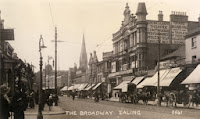When I began to create the storyboard, I found I would work from the scenes I had imagined in my head in the first lecture (Kitchener coming out of the poster, and everyone around the main character having Kitchener’s face after). I made a very crude, scribbled storyboard in my notebook, and stood back to see if it made sense. After a few alterations and improvements I moved on to create a more detailed storyboard on A3 for the pitch. Once completed, I practiced what I would say and how I would walk the client through each scene of the storyboard on the day.
 |
| Sheet 1 of 2 |
 |
| Sheet 2 of 2 |
I then moved on to the character designs. I wanted to create 3 for the pitch, the main character, the army recruiter and a woman that’d be on the street judging the main character. After completing the final design for the main character, I thought the upper body looked to square, the shirt looking too crisp brand new, that was too big for the boy. But found this was more actually more effective, as it strengthened the idea this main character is just a young boy too young to fight, wearing a military uniform made for men. Hinting the war is meant to be fought by men, not young frightened boys.
For the recruiter I decided I'd go with a more unnatural body shape – bigger head and upper body, smaller legs, and extremely large jaw- to make the recruiter look big, strong, essentially an actual soldier prepared for war. Which I feel it accomplishes.
I'm happy with the design of the woman aswell. Although I'm aware the fashion worn in the design is historically inaccurate, I didn't change it before the pitch because I wanted to see, if after seeing the colour and style of the design, they felt the more visually pleasing the design was better than the duller colours of an accurate design. But I made sure Id make immediate note of the inaccuracy in the pitch to show the clients it wasn't a mistake, or due to lack of research. I believe the design expresses the impressions I want the viewer to have about the character – a mean, judgemental woman.

I found that the session with the clients was beneficial. I heard from them what they wanted in it was still great to here from the clients mouth what they wanted. Although the Armouries mainly focused on the other 2 briefs they had, the ones involving animations and film focused on Leeds during the war, its history,people and contributions during the war. She gave us examples of some ideas they were looking for, aswell as presenting online sources we could use to find people who had an interesting or noteworthy story from the war, including diary entries made by the individuals during the war, and letters sent home to their loved ones in Leeds, all available on the Leeds Armouries website. They also provided online information resources we could use for the other 2 briefs, such as images and sideshows of weapons, clothing, people and locations relevant to the briefs, which were all revolved around WWII. The last part was relevant to mine as I needed to research fashion of the time period, both civilian and military personnel, aswell as the firearms and vehicles of the time. I also stayed to hear the NHS representative speak and discuss their briefs. I found it interesting, their session was more interactive, with group activities for us to do. He aswell gave ideas for their briefs, but his main priority was that we did not put any inaccurate stereotype of mental disorders into our films. Although it was interesting, I have decided to stay with the Armouries brief, because its still the one that interests me most. Even if it didn't, its the day before the pitch and I have done all the work towards this brief, so no backing out now!

















.jpg)




















.jpg)



















.jpg)
